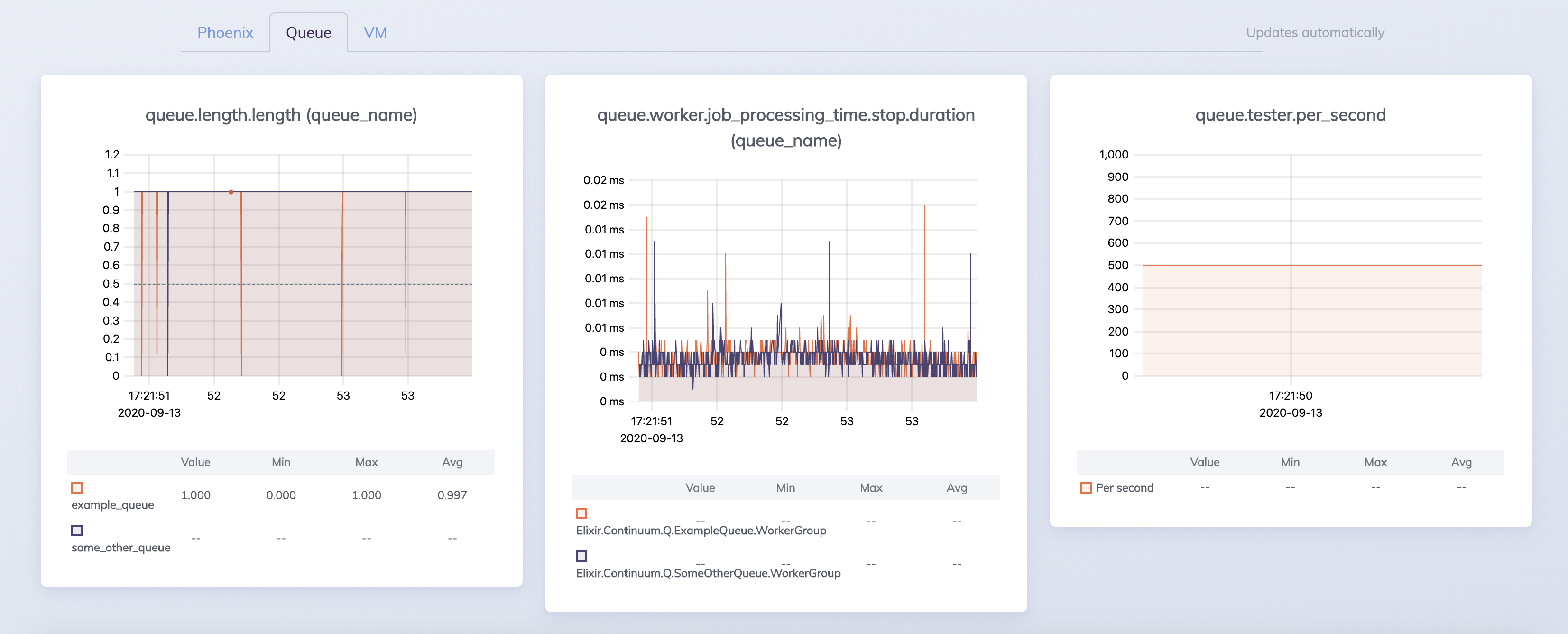Continuum
source startrek.com
Continuum is a queueing system.
This library is intended to be a drop-it-in-and-you're-running dependency. Step one is not configuring an external database. There's plenty of speed and features here to support many small and medium applications. This is not intended to support Google level traffic, because you're probably not Google.
Continuum is a durable FIFO (First In, First Out) job queue. Checking out jobs, clearing them on completion, and requeueing them on failure are supported. Additional features include:
- Retries
- "Dead Letter" queueing
- Worker pools
- Telemetry metrics
- Configurable limits
- Message size
- Message lifetime
- Queue length
- Worker timeouts
- Max retries
This project began life as a Spawnfest 2020 contest entry. We hope you enjoy it!
Design
We examined multiple strategies for building a queue on the file system, but settled for the "maildir" strategies that have powered email for so long.
At its core, Continuum serializes queued messages into files and then moves those files from directory to directory as a means of changing status. The atomic file move is the beating heart of this operation. Uniquely generated file names, based on timestamps and other criteria, ensure that processing directories in order maintains FIFO semantics. We can also track some details about attempted runs as a file moves through the system by appending flags to its name during a move. This flow doesn't require the use of file locks.
We have placed a layer of processes on top of these low-level data structures to provide niceties like minimal fuss worker pools. Application code transparently interacts with these processes to read and write from queues.
All systems have tradeoffs and ours is no different. The dependency on a file system means this project is not useful with deployments to hosts with ephemeral file system that are frequently blown away.
Our processes design is also currently write constrained. We've managed to reliably push 500 messages a second, as you can see in the following image.
To view these graphs on your own machine, start the Phoenix app in the
example/ directory and navigate to Live Dashboard, Metrics, then the Queue
tab.
We could absolutely reduce this bottleneck with more effort. The underlying data structures can support more volume, but doing so comes with new challenges and 500 messages a second meets plenty of needs!
Usage
Installation
Until this project is on Hex, you'll probably want to play with it from a local path with configuration like the following:
def deps do
[
{:continuum, path: "../continuum"}
]
endOr you can load it from GitHub:
def deps do
[
{:continuum, github: "spawnfest/continuum"}
]
endConfiguration
You configure Continuum by asking it to add processes into your supervision tree. The following example builds two queues with a shared "Dead Letter" queue:
def start(_type, _args) do
root_dir = Path.join([:code.priv_dir(:example), "queues"])
# setup your queues and their worker pools
queues = [
[
name: ExampleQueue, # a unique name for this queue
workers: 3, # the number of workers for this queue
function: &example/1, # the function workers pass messages to
root_dir: root_dir # the root directory to store queues in
],
[
name: SomeOtherQueue,
workers: 3,
function: &example/1,
root_dir: root_dir
],
]
# setup "Dead Letter" workers
dead_letters = [workers: 1, function: &dead_example/1]
children =
[
ExampleWeb.Telemetry,
{Phoenix.PubSub, name: Example.PubSub},
ExampleWeb.Endpoint,
{
Example.StressTester,
queues: [ExampleQueue, SomeOtherQueue]
}
] ++
Continuum.Q.build_with_dead_letters(queues, dead_letters) # add queues!
# See https://hexdocs.pm/elixir/Supervisor.html
# for other strategies and supported options
opts = [strategy: :one_for_one, name: Example.Supervisor]
Supervisor.start_link(children, opts)
endQueueing and Processing Jobs
You can queue jobs from anywhere with code like:
Continuum.Q.push(QueueNameFromConfig, any_term_as_a_message)You specify the number of :workers you want to run for each queue and a
:function reference they should pass messages to for working in your config.
See the example config above.
Team: Irregular Apocalypse
We're a small team of friends who live in the same city near the center of the United States.
Clayton Flesher
Clayton served as the idea man and primary stakeholder for this project. He dreamed up our plan, kept our eyes on the time limit, and changed our test output into rainbowy greatness. This is important stuff!
Paul Dawson
Paul served as our resident security expert. All attempts to add a few more bytes to a size limit or a few more seconds to a timeout earned stern glances from him. It's probably not his fault if your hard drive melts.
James Edward Gray II
James spent a large portion of the contest waxing rhapsodic about atomic file operations and the glories of email. It doesn't take a whole lot to amuse that guy.


